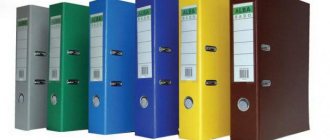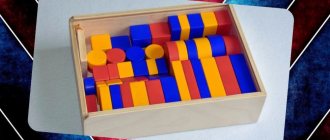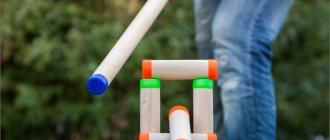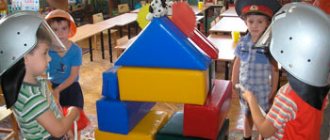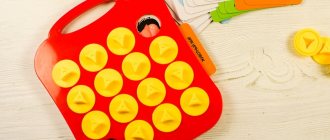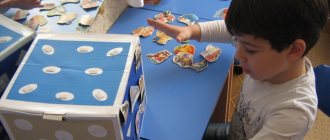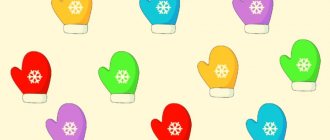Senior group. Senior preschool age. Children 5-6 years old
A card index of games with tongue twisters for children of the older group with general speech underdevelopment. A card index of games with tongue twisters for children of the OLDER GROUP ONR . Goal: Consolidate correct sound pronunciation; Working on a sense of rhythm; Expressiveness. In the chest on the ship 1) learning Carry the dishes. 2) pronounce exaggeratedly clearly 3) pronounce emphasizing the first thing with your voice...
Card file of didactic games in mathematics (senior group) CARD FILE OF DIDACTIC GAMES ON COGNITIVE DEVELOPMENT (FEMP)
(senior group)
Educator: Nurgalieva A.B.
Games are widely used when teaching the beginnings of mathematics. With their help, children’s ideas about numbers , the relationships between them, about...
Card index of didactic games for older children
Didactic games for older children
Card No. 1.
"Geometric figures"
Target
: introducing children to basic geometric shapes.
Material
: cards depicting a house, Christmas tree, sun, etc. from geometric shapes.
Progress of the game
. After talking about the pictures, ask the child to show a square (triangle, circle, rectangle), then trace the shapes shown with dotted lines with a pencil, and then color the picture. As you work, repeat the words with your child more often: “The ball is round, the window is square...”
Card#2
. “Find and name the figure”
Target
: exercise children in knowledge of geometric shapes.
Material
: cards with images of geometric shapes.
Progress of the game
. Invite your child to first color the figure in the frame, and then the same one, highlighting it from the other two. Ask him to name the shapes he knows and the color he chose to paint.
Card No. 3.
"Flags and garlands"
Purpose of the game:
develop children's logical thinking, exercise their knowledge of colors and geometric shapes.
Material
: cards depicting a garland of flags and other geometric shapes.
Progress of the game
. Invite the children to color in each first shape of the garlands and flags, then use a pencil to trace the shapes shown in the dotted line and color them in any color. Then ask the child to show and name the shapes, and also say what color he painted them.
Card No. 4.
"Chicken Family"
Purpose of the game
: to train children in recognizing and naming geometric figures, to develop children’s logical thinking.
Material
: plot picture depicting a chicken family, card depicting geometric shapes.
Progress of the game.
Look at the story picture (pre-colored) with your child. “Who is drawn? Who is dad and mom in the family? Where are the kids? How many chickens? What color are they?" Then offer a card with geometric shapes depicted and ask them to find in it those shapes that need to be cut out and glued to the image of a hen, rooster, chickens. Help your child cut it out and let him paste it himself. When you're done, rejoice at his success. You can invite the child to show the largest circle, a smaller circle and the smallest circles in the picture. At the end of the game, check which geometric figure you performed. Offer to find round objects in the surrounding space. Let the child draw circles with his finger on the table, on the floor, or in the air. You can suggest drawing circles on paper
Card No. 5.
"Sail"
Purpose of the game
: introduce children to the “triangle” shape, develop thinking.
Material
: plot picture depicting boats made of geometric shapes, card with geometric shapes.
Progress of the game.
Invite the children to talk about what is shown in the picture, then trace the sails with a pencil. Ask what geometric figure they resemble and what other geometric figures they know. After this, the children look for a small triangle, then a large one. Help them, if they find it difficult, to color, cut out and paste the shapes onto the image. At the end of the game, check which geometric figure you cut out. Offer to find triangular-shaped objects in the surrounding space. Let the child draw triangles with his finger on the table, on the floor, or in the air. You can suggest drawing a triangle on paper.
Card No. 6.
"Posting pictures"
Purpose of the game
: development of children’s logical thinking, consolidation of knowledge of geometric shapes.
Materials:
sample cards with designs of geometric shapes, blank cards, cut out geometric shapes of different colors and sizes.
Progress of the game
. Look at the drawings with your children. Offer to find familiar geometric shapes on them. Cut out shapes from colored paper in two copies and make appliqués from one with the children. Offer the second set of figures to the children for laying out images. Don’t forget to memorize the names of the colors in your children’s memory while playing. For the second image, cut out the shapes so that their shape is the same but their color is different, so that the child can find the part by both shape and color.
Card#7
. "Design according to the scheme"
Purpose of the game:
development of logical thinking in children of primary preschool age.
Material:
cards with contour diagrams, builder's details.
Progress of the game.
Children are given a card with contour diagrams and asked to lay out these images from large parts of a building set on the table, using this card as a sample. To make things more challenging for children, offer a few more parts than they need.
Card No. 8.
“Building from sticks”
Target:
consolidation of knowledge of geometric figures, development of logical thinking of children.
Material:
cards with outline images of objects, sticks of different lengths.
The goal of the game
. Offer the children sticks of different lengths, ask them to select the longest, shortest and shortest. At the child’s suggestion, make a figure out of sticks. Then give the child a card, look at the outlines of the objects with him, let him recognize them and name them. Then offer to lay out any figure. As you work, fix the names of familiar geometric shapes that will appear during the laying out process. Ask them to lay out figures of their own design with chopsticks.
Card#9
. "Find the figure"
Purpose of the game:
familiarizing children with the names of geometric shapes, introducing cones, cylinders and prisms.
Material
: building designer set, cards depicting geometric shapes.
Progress of the game.
Ask your child to find and bring a cube, a brick, then a long plate (use regular building material for construction). Show your child a cone and ask him to find the same part (then a cylinder, then a prism). After this, give the child a card and ask him to find these details.
Card number 10.
"Find a Pair"
Purpose of the game
: development of logical thinking, practice naming colors and naming geometric shapes.
Material:
cards with images of geometric shapes divided into 8 parts, uncut cards according to the number of players.
Progress of the game
. Invite your child to play a game. (One of the cards is cut into eight parts.) Place the cut cards on a whole card on the card (shapes identical in shape, but different in color and size). Pick up this or that card and ask to find the same part, but of a different color or size. When completing the task, practice naming colors for children.
Card No. 11.
“Build according to the scheme”
Purpose of the game
: teach children to carry out elementary constructions, focusing on diagrams.
Material
: building diagrams, construction kit.
Progress of the game
. Talk to your children about the building parts they know and show them their properties. Show the card, ask what is shown on it, offer to look at it, and say what parts the building is made of. Ask them to build the same buildings from building parts. It is important that the details are shown in actual size.
Card number 12.
“Putting on the details”
Purpose of the game:
teach children to lay out images using the overlay method.
Material:
cards with outline drawings, construction kit or flat geometric shapes.
Progress of the game.
Children are taught to lay out images by superimposing three-dimensional details of one of the faces on the drawing. Offer the children a map and ask them to create beautiful pictures (show with an example of installing one part).
Card#13
. "Laying out figures"
Purpose of the game
: exercise children in laying out images of geometric shapes using diagrams.
Material:
picture maps, construction kit.
Progress of the game
. Children are offered diagrams and geometric shapes to lay out images. After completing the task, they ask: “What figures did you use to make this car?” How many figures did you need for this rocket? How many identical figures are there?”
Card No. 14.
"Find the odd one out"
Purpose of the game:
develop logical thinking of preschoolers.
Material:
cards with images of geometric shapes.
Progress of the game.
The map shows rows of geometric shapes. Children are asked to look at them and determine what is unnecessary on them, then justify why.
Card#15
. “What does it look like?”
Purpose of the game:
develop children's visual and figurative thinking.
Material
: a set of planar geometric shapes.
Progress of the game.
The teacher shows the cut out geometric shapes one by one, names them and asks them to say what they look like. For example: ball - bun, sun, face, balloon, etc.
Card No. 16.
“We construct from sticks” Purpose of the game
: development of children’s logical skills.
Material:
sticks of different lengths in three sizes, cards with simple pictures.
Progress of the game.
Children are given sticks of different lengths and asked to divide them into three parts according to size. Then they give pictures (real images of simple-shaped objects: a flag, a car, a boat with a sail, a wheelbarrow, a flower, a vase, etc.) and ask them to lay out the image of these objects with chopsticks.
Card No. 17.
"Match"
Purpose of the game:
development of logical thinking of preschool children.
Material
: drawings depicting geometric shapes and real objects that are well known to preschoolers.
Progress of the game.
Children are offered two drawings, one depicting geometric bodies (cube, cylinder, ball, cone, etc.), the other showing real objects that are well known to preschoolers, and they are asked to name which geometric body this or that object is similar to. Invite the children to play the game “What does it look like?” - find objects in the surrounding space that resemble familiar geometric bodies. Ask the children to point out and name the round, square, and shapes in one and the other picture.
Card#18
. "Remember what it's like"
Purpose of the game:
Exercise children in naming geometric shapes.
Material:
cards with images of geometric shapes.
Progress of the game
. Children are offered cards with pictures of construction parts. The teacher asks to name the detail and remember objects that are similar to it, while justifying why he points out these objects.
Card No. 19.
"Count and design"
Purpose of the game:
Development of logical thinking in preschoolers.
Material
: Geometric robot cards, construction kits, or flat geometric shapes.
Progress of the game
. Children are shown a drawing depicting robots made from geometric shapes. The teacher offers to count the robotic men and asks how many robotic dogs there are. Asks you to choose any robot, tell what shapes it is made of, how many identical shapes and parts went into it. Then the children are given geometric shapes and asked to put their favorite images out of them.
Card#20
. "Arrange your room"
Purpose of the game:
development of logical thinking of preschool children.
Material:
sheet of paper (35*45cm), construction set, planar geometric figures
Game progress.
The teacher offers the children a sheet of paper (35*45 cm) and says that this is the floor of the doll’s room, asks them to build it with bricks (the walls of the room), leaving gaps for the window and door. After the children do this, take out the sheet and place it next to the constructed room. Then he takes out geometric shapes and offers to lay them out on paper, selecting pieces of furniture that are similar in shape (a square is a stool, a rectangle is a bed, etc.). The teacher reviews the resulting diagram with the preschoolers and asks them to arrange “furniture” according to it in a room built with bricks. At the end of the work, the children compare the image with the building.
Card#21
. “Name the quantity”
Goals:
to form in children a differentiated perception of the qualities of size.
Progress of the game:
children stand around the table. Pictures depicting objects of different sizes are laid out on the table in a circle. For example: a pencil is long and short. There is an arrow in the middle of the circle. The children spin it and say the words: “Arrow, arrow, turn around, show yourself to all the pictures. Show us quickly which one is your favorite. Children take the picture that the arrow points to and name the size of the objects.
Card#23
. “Relationship of geometric bodies and figures”
Purpose of the game:
teach children to correlate images of geometric shapes and construction parts of a construction set.
Material:
Cards with images of geometric shapes, construction set.
Progress of the game
. Preschoolers are asked to look at images of geometric bodies, and then at the geometric shapes shown below. The teacher asks to find the building parts shown on the card and show those sides that have the shape of the geometric shapes shown under the card. The task becomes more complicated if children are asked to correlate geometric shapes and bodies without using construction parts.
Card#24
. “Putting on the details”
Purpose of the game
: development of logical thinking in preschoolers.
Material
: diagram cards, construction parts.
Progress of the game
. Preschoolers are given two cards: on one, in the form of a diagram, various towers are depicted, on the other, building parts that should be selected to solve this problem. The goal of the task: to place the parts in the outline so that they come into contact with the surface of the sheet on one of the faces. In the process of solving a task, the teacher clarifies what parts the child uses, what color, what shape of edges this or that part has, how many edges the part has, how many parts went into assembling the image.
Card#25
. “Name the shape of the object”
Goals:
consolidate the ability to visually correlate the shape of an object with a standard.
Progress of the game
: children are divided into two teams. One team calls objects rectangular in shape, and the other - square. For each item named, children receive a chip. At the end of the game, it is revealed how many chips each team has earned.
Card#26
. Who will remember more?
Goals
: to consolidate in children the ability to visually recognize the color, shape, size of objects in the surrounding space, to develop visual attention and memory.
Progress of the game
: Several children take part in the game. They are asked to see around them as many objects of the same color, size, shape as possible within a few minutes. At a signal, one child begins to name, and the other complements.
Card#27
"Boxes".
Goals:
develop the ability to visually correlate objects by color, develop color discrimination and attention.
Game progress:
5-6 people play. On the tray there are small toys of four primary colors. The teacher shows 4 boxes. At the bottom of each there is a circle of a certain color (out of 4). Walking in a circle, the teacher opens one of the boxes. Children must take a toy from the tray and put it in this box of the same color as the circle in the box. Words: “On the bottom of the box there is a light burning, which toys to take. He tells us. Be careful not to mix it up, pay close attention to what color you put in the box.
Card#28
. “Pick an item by color”
Goals
: consolidate the ability to correlate color - as the main feature with the color of objects, develop visual attention, memory, spatial orientation.
How to play:
Children stand in a circle. There is a table in the middle. On it there is a card with circles of different colors (depending on age). There is an arrow in the middle of the map. The map is round. Children take turns turning the arrow, saying the words “arrow, arrow, turn around, show yourself to all the circles.” And which one is your favorite, show us quickly! Stop!" Which color circle the arrow points to, the object in the picture of that color should be placed next to the circle. Cards with outlines and silhouettes of objects lie on another table. For example: the arrow stopped on a burgundy circle. Next to this circle you need to put a silhouette or outline of a beet. Everyone turns the arrow one by one. Complication: you can select several silhouettes or contours of objects of a given color for a colored circle.
Card No. 29.
"Arrange it as I say"
Target:
develop visual memory, differentiation of flat geometric figures, visual attention, orientation in microspace.
Progress of the game:
Different geometric shapes lie in front of the children. The teacher makes sure that the children know their names. Then the teacher invites the children to lay out these figures in a certain order. The order can be very different: from left to right, from top to bottom, according to a sample, from memory, in a certain sequence, according to counting (lay out so that the second is a trapezoid, the fourth is a rhombus, etc.).
Card#30
. “One, two, three, as you walked - name it.”
Target:
development of orientation in micro space, in directions (right, left, top, bottom).
Game progress
: The children are shown a labyrinth. You need to help the bunny get to the hare. To help, you need to run your finger through the maze and say the words: “I play with the maze, I run along the path. My finger goes and goes, but where will it lead? One, two, three, whatever you call it.” The child tells how first the finger went to the right, then up, then to the left, etc. Complication: the labyrinth is crossed by a labyrinth of a different color. You can make the directions more complicated.
Card#31
. "Twelve months".
Target
: develop orientation in time (names of months), seasons, auditory attention.
Progress of the game
: the teacher lays out cards with numbers from 1 to 12 on the table and mixes them. The players take cards and arrange them in order according to the number indicated on the card. They turned into 12 months. The teacher asks questions: “First month - what is your name?” “Twelfth month - what’s your name?” “Sixth of the month, what’s your name?” etc. You can give a hint - write the first letter of the month on the back side.
Card#32
. “Take a guess.”
Target
: develop the idea that the same object looks different depending on the observer.
Progress of the game
: children sit in pairs at tables opposite each other. In the middle of each table there is an object that has pronounced differences between the front and back sides (watch, tumbler, teapot, etc.) One driver is selected. He turns away and says a rhyme. At this time, the rest of the children schematically sketch the object in front of them as they see it. Then all the drawings are mixed and the words are said: “Guess, guess whose drawing - guess.” The driver turns, takes the drawing and tries to find the author.
Card No. 33.
“Locate the toy”
Target
.
Achieve the ability to pronounce a phrase of five to six words together, on one exhalation. Development of prolonged speech exhalation. Progress of the game
: The teacher lays out various children's toys (car, pyramid, ball, bear, doll, etc.) on the table in one row. Calling the child, he asks: “Between which toys is the pyramid?” The child must give a complete answer: “The pyramid is between the car and the ball.” After two or three answers, the adult changes places of the toys. Gradually, as you repeat the game, you can replace the toys with others one by one. Methodical instructions. When conducting the game, the teacher makes sure that the children speak slowly, without separating one word from another with long pauses. You must answer the question with a complete answer, for example: “The ball lies between the doll and the bear.”
Card No. 34.
Exercise "Divers"
Target.
Teach children to inhale through their mouth and exhale through their nose.
Development of differentiated breathing. Progress of the game
: Children, spreading their arms to the sides, inhale through their mouths. Wrapping your arms around yourself and squatting (“sinking under the water”), exhale through your nose. Methodical instructions. Each child repeats the exercise no more than two or three times.
Card No. 35. "
Guess what to do"
Target.
Teach children to determine the tempo of speech by ear and perform movements at the appropriate pace.
Development of the ability to detect by ear changes in the tempo of speech. Progress of the game:
The teacher pronounces the phrase: “The mill grinds grain” several times at different tempos. Children, imitating the operation of a mill, make circular movements with their hands at the same pace at which the teacher speaks. The following phrases are also played out: “Our feet walked along the road”, “The children swam in the river”, etc.
Methodical instructions. An adult should pronounce the phrase smoothly, continuously, repeating it 2-3 times in a row at any pace, so that it is easier for children to perform the movements.
Card#36
. "Snowstorm".
Target.
Teach children to change the strength of their voice from quiet to loud and from loud to quiet in one exhalation.
Changing the strength of the voice. Progress of the game
: The teacher shows a picture of a blizzard. Children sitting in a row depict a blizzard howling on a winter evening. At the teacher’s signal “the blizzard is starting”, the children quietly say: “uuu...”; at the signal “strong blizzard” they say loudly: “uuu...”; at the signal “the blizzard ends” they speak more quietly; at the signal “the blizzard is over” they fall silent.
Methodical instructions. It is advisable that children pronounce the sound quietly on one exhalation, then loudly and quietly again, so the adult quickly replaces one signal with another.
Card#37
. "Poultry farm"
Target.
Development of speech breathing.
Teach children on one exhale: pronounce 3-4 syllables. Progress of the game
: An adult shows the toys to the children and plays their sounds 3-4 times in a row. The toys are put away. The teacher says: “Let’s go to the poultry farm. Let's go, and towards us... (shows a chicken) chicken. How will she greet us? Children: “ko-ko-ko.” “We moved on.” A goose is coming towards us. How will he greet us? Children: "ha-ha-ha." Next, the teacher sequentially shows the remaining toys, and the children pronounce the corresponding onomatopoeia. Methodical instructions. First, all the participants in the game speak, then you can ask three or four children one at a time. Make sure that children pronounce onomatopoeias (ko-ko-ko, ha-ha-ga, pi-pi-pi, ku-ka-re-ku, quack-quack-quack) in one exhalation. Some children can pronounce 2-3 onomatopoeias, others - 3-4.
Card#38
. "The wind blows"
Target.
Teach children to use a loud or quiet voice depending on the situation.
Changing the strength of the voice. How to play:
Children sit in a semicircle on chairs. The teacher says: “We went for a walk in the forest in the summer. We are walking through a field, the sun is shining, a light breeze is blowing and the grass and flowers are swaying (shows a picture). He blows quietly, like this: “oo-oo-oo” (pronounces the sound u quietly and for a long time). We came to the forest and picked a lot of flowers and berries. We got ready to go back. Suddenly a strong wind blew (shows a picture). He hummed loudly: “oo-oo-oo...” (pronounces this sound loudly and for a long time). Children repeat after the teacher how a light breeze blows and how a strong wind hums.
Methodical instructions. The teacher makes sure that the children, repeating after him, maintain the same strength of voice.
Card No. 39.
“Who is attentive?”
Target
.
Teach children to correctly perceive verbal instructions, regardless of the strength of the voice with which they are pronounced. Development of physical hearing acuity. How to play:
Children sit in 3 rows opposite the teacher’s table. (First row at a distance of 2-3 m). There are various toys on the table. The adult says: “Children, now I will give tasks to those who are sitting in the front row. I will speak in a whisper, so I need to sit quietly so that everyone can hear. I will call everyone by name and give them a task, and you check whether it is being completed correctly. Be careful. Vova, take the bear and put it in the car.” Methodical instructions. The teacher needs to make sure that the children sit quietly and do not prompt each other. Assignments should be short and simple.
Card number 40.
“I can - I can’t.”
Goals:
focus children's attention on their skills and physical capabilities of their body;
develop self-esteem. Equipment:
ball.
Progress of the game:
The presenter throws the ball and says: “I know how” or “I don’t know how.” The child, having caught the ball, continues the phrase, explaining why he can or cannot do it. For example: “I can run because I have legs. I can't fly because I don't have wings."
Card No. 41.
"Guess who called?"
Goals:
train the hearing organs and activate the attention and auditory memory of children.
Equipment
: Ball.
Progress of the game:
The presenter, standing with his back to the children, must determine by his voice who called him. If the answer is correct, the place of the leader is taken by the child whose vote was determined.
Card No. 42.
"Find a pair."
Target
: select a pair to an object based on tactile sensations (blindfolded).
Equipment:
buttons, cubes, apple, pencils, small objects.
Progress of the game:
correctly identify different materials by touch.
Card#43
. "Guess the riddle from the picture."
Goals:
Help children remember the main group of dangerous objects and develop attention.
Equipment
: pictures depicting dangerous objects.
Progress of the game:
An adult asks a riddle, and children guess and find the corresponding picture. An adult asks you to think and say why these objects are dangerous? Children tell what danger each object poses.
Card No. 44.
Find dangerous objects.
Goals:
help children remember objects that are dangerous to life and health;
help you draw your own conclusions about the consequences of not handling them carefully. Equipment:
knife, scissors, needle, iron.
Progress of the game
: Andryusha and Natasha remain in the apartment. Their parents went to work. Let's tell the kids what objects they can't use so that trouble doesn't happen. Children repeat the safety rules: All sharp, piercing, cutting objects must be put back in their place; Do not turn on electrical appliances; they may cause electric shock or cause a fire; Under no circumstances should you try medications - they are poison; You cannot try washing powders, dishwashing detergents, soda, bleach; It is dangerous to go out onto the balcony alone.
Card No. 45.
Ambulance.
Target:
strengthen children's knowledge and practical skills in first aid.
Equipment:
pictures depicting medical supplies (thermometer, bandage, brilliant green).
Progress of the game
: The teacher plays out with the children a situation where a person has cut his arm, leg, broken his knee, elbow, has a fever, has a sore throat, has a speck of dirt in his eye, and has a nose bleed. For each situation, work out the sequence of actions.
Card#46
. Pick a pair.
Goals:
correlate objects in pictures with actions;
strengthen self-care skills; develop logical thinking. Equipment:
subject pictures: vacuum cleaner, comb, battery, soap, toy cabinet;
subject pictures: cleaning the apartment, boots, clothes, toys. Progress of the game:
Children carefully examine the pictures received, compare them and select pairs, explaining their choice.
Card#47
. What do you know.
Goals:
talk about the structure, work, characteristics of the human body, rules for caring for it, first aid in various situations, develop attention and memory.
Equipment:
ball, incentive prizes.
How to play:
Children sit on chairs in front of the teacher, the teacher - the driver throws the ball to the child and asks: “What do you know... (for example, about the heart)?” The child who caught the ball answers. The rest of the children listen attentively, those who wish to complete the answer, those who drop the ball lose the right to answer. Children should not interrupt each other, complement only after the answer is completed. At the end of the game, the most active player receives an incentive prize.
Card#48
. "Enchanted City"
Purpose of the game
: consolidate children’s ideas about the architecture of modern buildings and structures;
introduce you to the architectural features of the city. Materials
: album with outline images of buildings and other structures of a modern city; photographs depicting the same buildings and structures.
Progress of the game:
"disenchant" the city. Tell children about the buildings and structures of their native village. Before the game starts, the teacher conducts a mini-conversation with the children: -What is the name of our country? -What is the name of the city where you live? -How long ago was our city founded? -Which streets of the city do you know? -What is the name of the street where you live? -What monuments of our city do you know? -What ancient monuments are there in our city? -What great people who glorified our city do you know? -How did you know that? Who told you about this? -What else would you like to know about our city? The teacher invites the children to look at an album with the outlines of buildings, then photographs of the same structures and compare the outlines with the photographs. For example: the outline of the Planetarium building is a photograph of the planetarium building.
Card#49
. Traveling around the city
Target:
introduce your hometown
Material
: album of photographs of your hometown
Game progress:
The teacher shows the children photographs of the city’s attractions, suggests calling them
Card No. 50.
Riddles about the city
Target:
introduce you to your hometown
Material:
Cards with riddles about the city or your home village.
Progress of the game
: The teacher asks the children riddles from the life of their hometown.
Card#51
. Flag of Russia
Target:
contribute to consolidating knowledge of the flag of their country
Material:
stripes of red, blue and white
Progress of the game:
The teacher shows the children the Russian flag, removes it and offers to lay out the multi-colored stripes in the order in which they are on the Russian flag.
Card No. 52.
Where is the monument located?
Target
: introduce children to monuments, teach them how to navigate their hometown.
Material:
images of monuments
Game progress:
The teacher shows children images of monuments and asks them to tell where this monument is installed.
Card#53
. Birds of our city
Target
: introduce children to the birds of their hometown
Material:
cards with images of birds
Game progress:
The teacher shows the children cards with images of birds, asks them to name and determine whether the bird lives in our city or not
Card No. 54.
"Cows, dogs, cats"
close your eyes and forget human language. You should only speak the way your animal “speaks.” You can walk around the room without opening your eyes. As soon as you hear “your animal,” move towards it. Then, holding hands, the two of you walk together to find other children who “speak your language.” An important rule: do not shout and move very carefully.” The first time you play the game, you can play it with your eyes open.
Card#55
. "Press conference"
Goals:
develop effective communication skills;
cultivate a desire to communicate and make contact with other children; teach children to ask various questions on a given topic and maintain a conversation. Progress of the game
: all children of the group participate. Any well-known topic is chosen, for example: “My daily routine”, “My pet”, “My toys”, “My friends”, etc. One of the participants in the press conference - the “guest” - sits in the center hall and answers any questions from participants. Sample questions for the topic “My friends”: Do you have many friends? Are you more interested in being friends with boys or girls? Why do your friends love you, do you think? What should you be like to have more friends? What should you not do with your friends? Etc.
Card#56
. "Secret"
Goals:
develop a desire to communicate with peers;
overcome shyness; find different ways to achieve your goal. Progress of the game
: the presenter distributes small objects to all participants: a button, a brooch, a small toy,…. It's a secret. Participants pair up. They must persuade each other to show their “secret”. Children must come up with as many ways of persuasion as possible (guessing; giving compliments; promising a treat; not believing that there is something in the fist, ...)
Card No. 57.
"Meeting"
Target:
Develop communication skills
Game progress
: Children break into pairs and tell each other about how they went to kindergarten in the morning.
Card#58
. "Let it always be"
Target:
promote improved communication with peers.
Progress of the game:
The presenter tells the children that one little boy came up with the following words: “May there always be sun, may there always be sky, may there always be mother, may there always be me!”
After this, the presenter invites everyone to come up with their most cherished “LET”. All the children shout in chorus: “Let it always be...”, and one of the children adds his wish, then the same is done for all the children in the group. Card No. 59.
"Volcano"
Target:
promote improved communication with peers.
Progress of the game
: One of the guys - “volcano” - squats in the center of the circle. He's sleeping. Then he begins to hum quietly and slowly rises - wakes up. The group helps him hum with dull uterine sounds - the sounds of the earth. Then he jumps up sharply, raising his hands up, as if throwing away everything he doesn’t need, then gradually falls asleep again. After the child returns to the circle; the presenter asks him what he threw away - maybe it was unnecessary feelings, thoughts, or maybe something else?
Card No. 61.
"Blackbirds"
Target:
development of communication skills, fostering a friendly attitude towards peers.
Progress of the game:
Children are divided into pairs, repeat the words and actions after the teacher: I am a blackbird, Point to themselves. And you are a blackbird. Point at their partner. I have a nose, They touch their nose. You have a nose. They touch their partner's nose. My lips are sweet, they touch their lips. Your lips are sweet. They touch their partner's lips. My cheeks are smooth, They stroke their cheeks. Your cheeks are smooth. They stroke their partner's cheeks.
Card No. 60. "
I know five names of my friends"
Target:
promote improved communication with peers.
Progress of the game:
One of the children hits the ball on the floor with the words: “I know five names of my friends. Vanya - one, Lena - two...”, etc., and then passes the ball to another child. He does the same and passes the ball to the next one. The ball must go around the entire group.
Card#62
. “We say hello without words”
Target:
develop the ability to use gesture and posture in communication.
Progress of the game
: Children are divided into pairs. Each couple comes up with their own way of greeting without words (shake each other's hand, wave, hug, nod, etc.). Then everyone gathers in a circle, and the couples take turns demonstrating how to greet each other.
